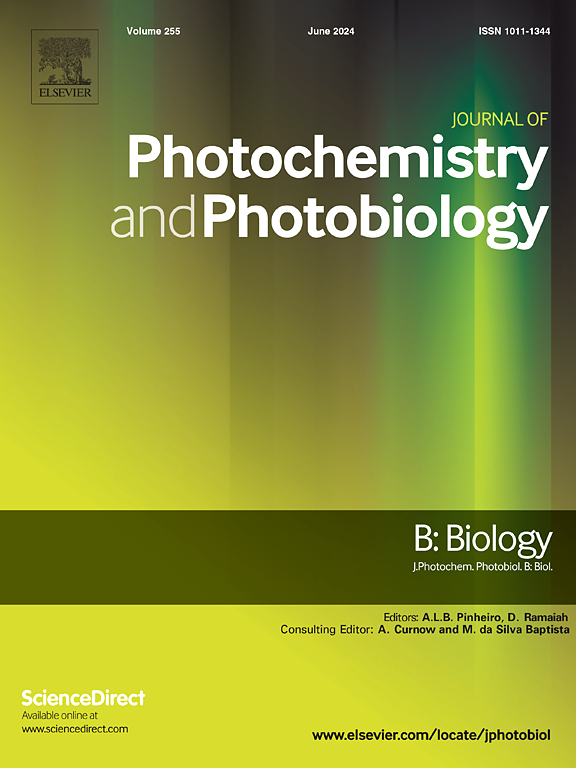III型胶原通过调节mTOR信号通路抵抗UVB诱导的HaCaT细胞光老化
IF 3.7
2区 生物学
Q2 BIOCHEMISTRY & MOLECULAR BIOLOGY
Journal of photochemistry and photobiology. B, Biology
Pub Date : 2025-04-10
DOI:10.1016/j.jphotobiol.2025.113153
引用次数: 0
摘要
紫外线(UV)是导致皮肤光老化的主要因素。在光老化过程中,细胞外基质的动态平衡被打破,导致活性氧(ROS)增加,基质金属蛋白酶(MMPs)积累,胶原合成减少,降解增加,皮肤变得松弛、起皱、色素沉着,最终导致皮肤老化。目的观察III型胶原(COLIII)对紫外线B (UVB)诱导的人永生化角质形成细胞(HaCaT)自噬水平的影响,探讨COLIII是否能通过改变自噬水平来抑制皮肤光老化。方法采用UVB照射HaCaT细胞建立光老化模型,检测细胞迁移修复能力、氧化应激和炎症水平、自噬水平,探讨COLIII对光老化HaCaT细胞自噬的影响及机制。结果vb辐射抑制细胞增殖和迁移修复能力,导致HaCaT细胞中ROS、炎症因子IL-6和MMP-1升高,COLIII能减弱UVB辐射引起的光毒性,抗光老化。此外,COLIII可以通过mTOR信号通路影响自噬水平,保护HaCaT细胞免受UVB诱导的细胞毒性,从而减弱光损伤。结论coliii通过mTOR途径抑制UVB照射HaCaT细胞的自噬水平,从而对抗UVB诱导的皮肤光老化。本文章由计算机程序翻译,如有差异,请以英文原文为准。
Collagen type III resists UVB induced photoaging of HaCaT cells by regulating mTOR signaling pathway
Background
Ultraviolet (UV) is the main factor leading to skin photoaging. In the process of photoaging, the dynamic balance of extracellular matrix is broken, resulting in the increase of reactive oxygen species (ROS), the accumulation of matrix metalloproteinases (MMPs), the decrease of collagen synthesis and the increase of degradation, and the skin becomes loose and wrinkled and pigmented, eventually leading to skin aging.
Objective
To investigate the effect of collagen type III (COLIII) on the autophagy level of human immortalized keratinocytes (HaCaT) induced by ultraviolet B (UVB) and explore whether COLIII can inhibit skin photoaging by changing the autophagy level.
Methods
HaCaT cells were irradiated with UVB to establish a photoaging model, and then the cell migration and repair ability, oxidative stress and inflammation levels, and autophagy levels were detected to explore the effect and mechanism of COLIII on autophagy in photoaged HaCaT cells.
Results
UVB radiation inhibited the cell proliferation and migration repair ability, resulting in the increase of ROS, inflammatory factors IL-6 and MMP-1 in HaCaT cells, while COLIII could attenuate the phototoxicity caused by UVB radiation and resist photoaging. In addition, COLIII can affect the level of autophagy through mTOR signaling pathway and protect HaCaT cells from UVB induced cytotoxicity, thereby attenuating light damage.
Conclusion
COLIII inhibits the autophagy level of UVB irradiated HaCaT cells through mTOR pathway, so as to combat UVB induced skin photoaging.
求助全文
通过发布文献求助,成功后即可免费获取论文全文。
去求助
来源期刊
CiteScore
12.10
自引率
1.90%
发文量
161
审稿时长
37 days
期刊介绍:
The Journal of Photochemistry and Photobiology B: Biology provides a forum for the publication of papers relating to the various aspects of photobiology, as well as a means for communication in this multidisciplinary field.
The scope includes:
- Bioluminescence
- Chronobiology
- DNA repair
- Environmental photobiology
- Nanotechnology in photobiology
- Photocarcinogenesis
- Photochemistry of biomolecules
- Photodynamic therapy
- Photomedicine
- Photomorphogenesis
- Photomovement
- Photoreception
- Photosensitization
- Photosynthesis
- Phototechnology
- Spectroscopy of biological systems
- UV and visible radiation effects and vision.

 求助内容:
求助内容: 应助结果提醒方式:
应助结果提醒方式:


